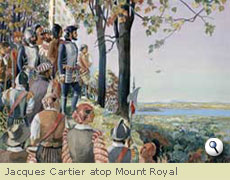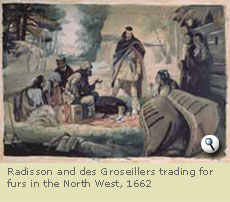Trading networks across North America were already well established by the time Europeans arrived. Natives revealed the New World to these European explorers, showing them their routes and teaching them survival techniques.
Even before the beginning of the fur trade, French and English explorers were seeking a quick passage to Asia in the hope of finding valuable spices. While they didn't discover these coveted riches, they did find another resource - furs - whose value they would only realize in the 17th century. They turned to colonization, and demand for furs developed gradually.
Fed by a conflict that started in Europe, the race to lay claim to the New World transported French-English rivalry overseas. Kings and queens, looking to expand their dominions and fortunes, were the first to pay for explorations. Afterwards, private investors picked up the costs.
While the English accessed the continent's interior via Hudson Bay, the French entered from the east. They forged a route from the Saint Lawrence River to the Mississippi, and from there into the heart of North America.
In 1534, French explorer Jacques Cartier reached America via the Saint Lawrence River. Samuel de Champlain followed in 1608. Two years later, Henry Hudson sailed into the bay that bears his name. Later in the century, Médard Chouart Des Groseilliers and Pierre-Esprit Radisson travelled as far as Lake Superior in search of furs. They were instrumental in the founding of the Hudson's Bay Company (HBC) in 1670.


After Cartier failed in his quest for gold and riches, the French turned their attention to colonization. Increasing demand for furs in Europe stimulated the development of trade in the New World.
From the 17th to the 19th centuries, explorers travelled farther and farther inland, making maps that combined their observations with Native knowledge.
In 1731, La Vérendrye obtained permission from New France to set up trading posts west of Lake Superior, and to undertake expeditions to the Western Ocean. La Vérendrye's later travels took him as far as the Saskatchewan River.
By the mid-1700s, furs accounted for about 70% of commodities exported from New France. French political power in the New World was soon challenged by Britain, and at the close of the Seven Years War (1756-1763) France ceded its colony to Britain. Soon after, British merchants arrived in Montreal and became involved in the fur trade. These new Montreal-based explorers built on earlier French accomplishments. Relying on French traders and canoe men, they led a push into the North West in order to develop trade. In 1778, Peter Pond, accompanied by Native guides, crossed the Methye Portage. This portage was a gateway to the Athabasca, a region rich in furs. One year later, several Montreal-based traders created the North West Company (NWC).
The NWC contributed greatly to the growth of the fur trade by financing exploration and pushing it westward as far as the Pacific Ocean. However, these achievements would not have been so successful without Native help.
| Previous | Top of page | Next |